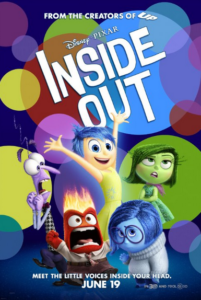
 Emotions personified. Pixar gets personal with the smaller but deeply affecting “Inside Out.”
Emotions personified. Pixar gets personal with the smaller but deeply affecting “Inside Out.”
When youngster Riley’s parents uproot the family and move from the midwest to San Francisco, two of her emotions, Joy and Sadness, get lost. And that’s when the empty malaise takes over and Riley gets awfully depressed.
We meet Joy (Amy Poehler) when Riley (Kaitlyn Dias) is born. Joy is “joy,” a perky emotion that many of us lack. She is stationed in what appears to be some sort of control room presumably in Riley’s mind. Shortly thereafter, other emotions appear in the control room there with Joy. They are Sadness (Phyllis Smith), Fear (Bill Hader), Anger (Lewis Black) and Disgust (Mindy Kaling). And by working together, Riley experiences a wide range of emotions, sometimes through a combination of parts of each of the five-entity team. But when Joy and Sadness are accidentally released from the control room, Riley’s perfect balance is upset. Watching the little girl melt into apathy or worse is tough to see. It is a progression that some will find cutting to the bone–the genuine and unexplainable depression of a child.
The control room is a unique creation. This is where Joy monitors Riley’s daily activities that are conveniently and efficiently recorded onto glowing orbs. These colorful rounded bits of memory are fed through various tubes to places in Riley’s brain, with some of the memories finding their way to a special holding container located within the control room itself. After observing these fantastical mechanisms and ethereal beings, I bought the setup entirely.
A much more intimate Pixar tale told intentionally within the confines of a little girl’s psyche, “Inside Out” will directly appeal to both the youngest and the oldest in the audience. And the meaning of it all will be universally poignant. In the past, Pixar has given human characteristics to tangible creatures like robots, cars, toys and even a rat with a talent for cooking. But here, they create beings of complete imagination–fantastics of the mind. The risk is that these entities might come off weightless and too foreign to be impactful.
But by living up to the film’s title and dealing with Riley’s emotional vacancy from the inside out, the fantastical is tempered with the concrete. The action takes place both inside Riley’s brain, where Joy and Sadness take a journey through various recesses, and the action parallels in the real world, where Riley struggles to comprehend what her feelings mean. The dichotomy is splendid with one enhancing and feeding on the other.
It goes without saying that the animation is mighty fine here. Some may find the emotions and the environment they inhabit more targeted at younger viewers and possessing a Disney quality that Pixar, despite its business connection with the Mouse House, normally rejects. But by also giving us action outside the fantastical world, the images are complementary. Seeing the film in 2D would be sufficient, I think. The 3D gimmick adds little.
But what always sets a Pixar film apart from its often lesser animated brethren is the strength of the story. And “Inside Out” deals maturely with depression and handles it in a complex and human manner. I dare not spoil the secret that may seem obvious at some point but will still resonate profoundly. The power of the moving image in affecting us and helping to shape our thoughts and compassion is on full display in animated form once again.
In addition, “Inside Out” is being released to theaters preceded by a short film called “Lava” directed by James Ford Murphy. This terrific animated short tells the tale of a volcano who pines away the years lonely and searching for a partner. The story is told through song, sung by Napua Greig and Kuana Torres Kahele, and it is really sweet and infectious. The combination of both films will help to make for a very special trip to the metroplex with someone you care about.
